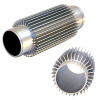redneck2
Member
I have a custom .358 WSSM upper on my AR that I use for deer hunting. Shilen Ultra Match blank IIRC. When I asked the gunsmith how much weight fluting saved, he paused and said "no one has ever asked"
He weighed one that was fluted, one plain. Saved half a pound on my rifle. It's a bull barrel and real heavy anyway, so the weight saving was worth it to me.
FWIW, mine shoots three shot groups in the .4's
I also have a Weatherby in .243 that has a fluted barrel. On that rifle, I really don't care one way or another. That's the way it came so that's what I use.
He weighed one that was fluted, one plain. Saved half a pound on my rifle. It's a bull barrel and real heavy anyway, so the weight saving was worth it to me.
FWIW, mine shoots three shot groups in the .4's
I also have a Weatherby in .243 that has a fluted barrel. On that rifle, I really don't care one way or another. That's the way it came so that's what I use.


